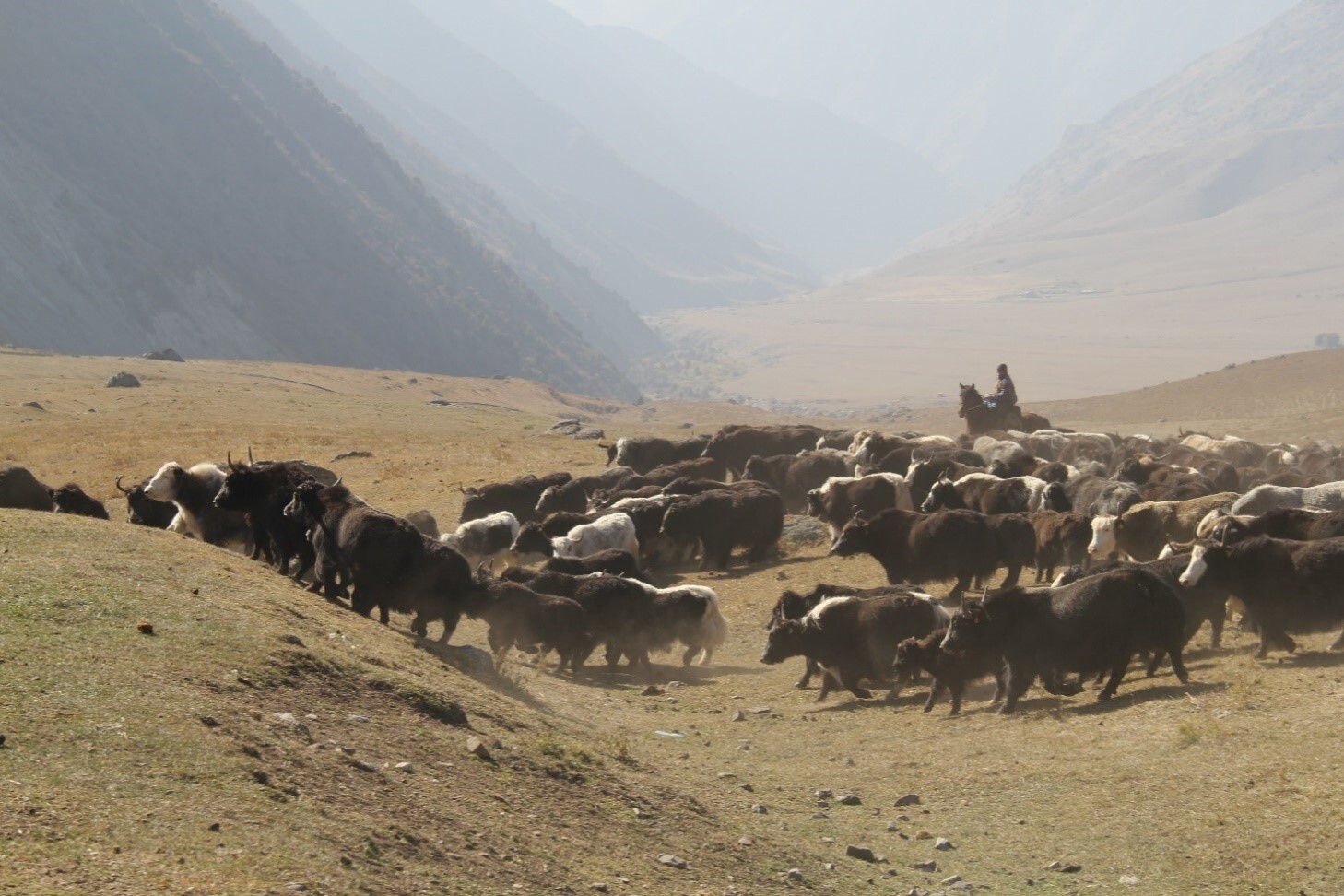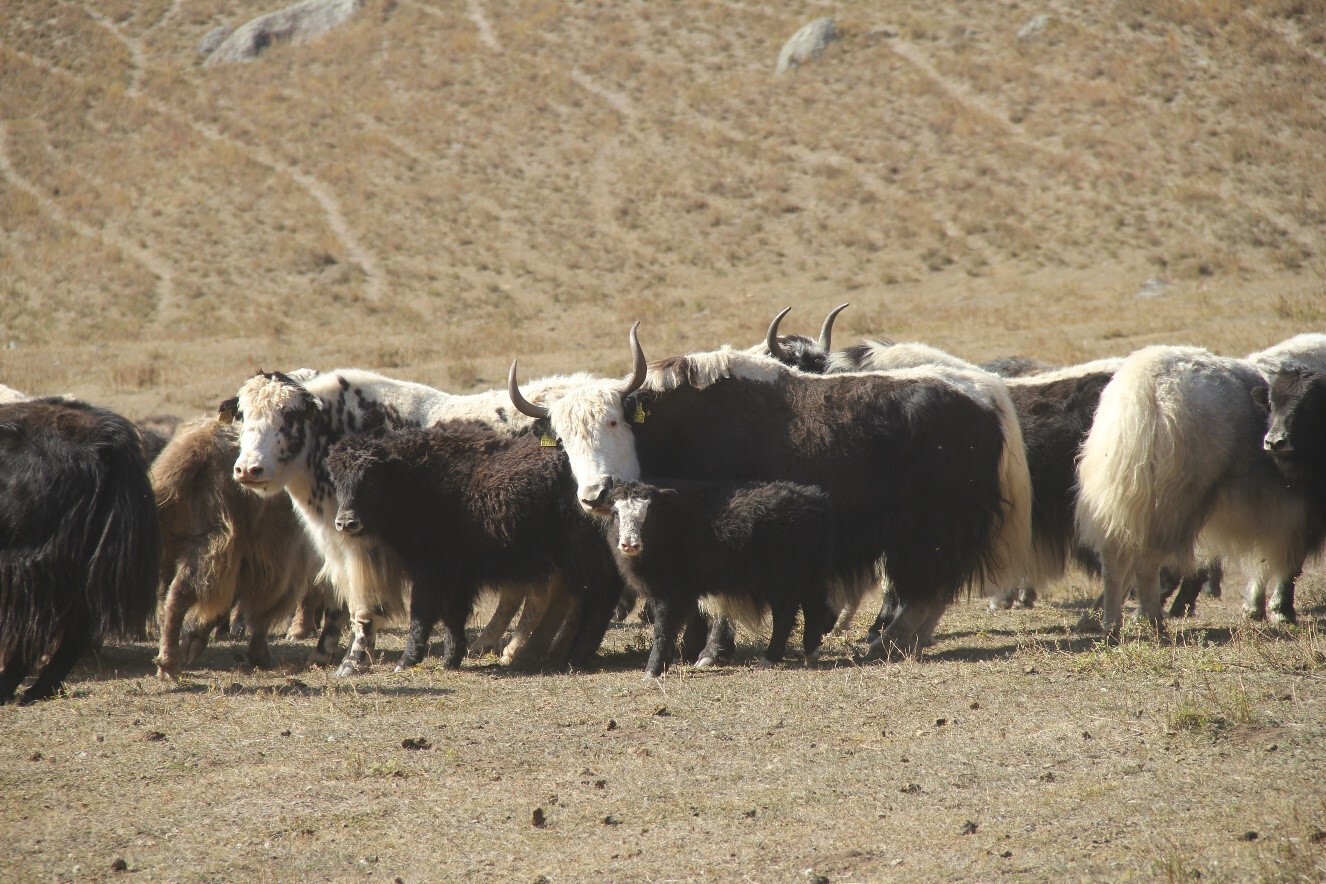"Yak Herding in Kyrgyzstan: Traditional Knowledge and Modern Practices" Study
conducted within the “Power-Bank of Climate Resilience: Revitalization of Yak Herding Cultures on Highlands of Central and Inner Asia” project
The rapid human-induced climate change exacerbates the vulnerability of ecosystems, accelerates the degradation of natural resources, and reduces biodiversity. It also affects the most vulnerable groups - local communities living in remote mountainous regions, whose livelihoods directly depend on natural resources. Along with that, it was noticed that the traditional knowledge of local communities, obtained during their interrelations with ecosystems, is gradually fading away. Traditional types of activities are changing due to external factors and are replaced by new practices, necessary for sustaining livelihoods, however, new knowledge is rarely based on rational and careful relation towards nature.
The livelihoods of local communities in remote mountainous regions are based on specific activities conducted by local people and available natural resources. The traditional use of natural resources historically was centered on Indigenous ecology. One of the important types of activities in such conditions, ensuring the well-being of local communities in remote areas, is traditional Yak breeding systems. Yak breeding does not require high expenses in comparison to keeping other types of animals and is suitable at high altitudes and harsh climatic conditions on remote pastures, while its products are ecologically pure and healthy.
The project "Power-bank of climate resilience: revitalization of yak herding cultures on highlands of Central and Inner Asia" aimed to revive centuries-old, original traditions associated with the manifestation of solidarity and interaction between the indigenous peoples of Asia, which focus is at promoting the nomadic culture. The project focused on ensuring the sustainable development of yak husbandry and supporting yak farmers in Kyrgyzstan, as well as establishing a network or association of yak farmers to promote the sector, exchange experiences, and create conditions for the preservation of traditional knowledge on yak husbandry and sustainable use of natural resources. Activating and strengthening indigenous practices and knowledge in climate change adaptation and mitigation are considered as an important dimension.
The study aimed to assess the conditions of yak herding as a sustainable livestock husbandry sector, to explore the capacities and challenges faced by livestock farmers in the process of sector development, and to study traditional knowledge. The study was conducted in 3 high altitude regions of Kyrgyzstan: Naryn oblast, Jalalabad oblast, and Chui oblast. It also included interviews with yak herders from Buryatia.
Based on the research, data analysis and field information, we can conclude as follows:
- Rangeland pastoralism is an essential sector of agriculture due to the ideal conditions associated with the landscape and the availability of pastures. There are plenty of high-altitude pastures accessible only to certain types of animals, such as yaks. The share of yak breeding is small, but the number of yaks in Kyrgyzstan is also growing year by year.
- Yaks are crucial for maintaining a healthy ecosystem and enhancing climate resilience. Yak keeping and care practices are based on the sustainable use of natural resources, a careful approach to the needs of yaks, and consideration of the landscape and climate peculiarities. Practices have evolved over time and adapted to changing environments driven by diverse resource management and livestock management systems, however, they are rooted in traditional knowledge.
- Yak breeding is very profitable; because the yaks stay on pasture forage without winter fodder, yak keeping cost is quite small.
- There is creativity in the life of yak breeders manifested also in herding techniques, manufacturing of tools, national clothing, elements of housing, national cuisine, verbal and written works, handicrafts, and many other things. The harmonious life of the aboriginal man is based on family values, the complementarity, and duality of women and men, the uniqueness of their views, and artistic discoveries.
- Yak-breeding activity is a cycle of precise practices designed to achieve harmonious coexistence in the mountain environment. Therefore, the traditions, customs, grazing methods, traditional ecological knowledge, and cultural expression of indigenous peoples are similar across the different regions where the yak breeders live.
- As a part of the yak breeders' life, creativity appears also in the technologies of grazing, making tools, national clothing, elements of housing, national cuisine, verbal and written art, handicrafts, and many other things. The balanced life of the indigenous people is based on family values, the complementarity and duality of women and men, and the uniqueness of their views and creative discoveries.
- There is a lack of associations of yak farmers, both at the national and regional levels, required to discuss and define the problems of yak farming, find common solutions and promote sustainable development of the yak breeding sector. Such associations are important to pool capacities for further analysis of problems and their solutions, and to preserve traditional yak farming under current conditions.
- The existing yak population does not negatively affect the pasture condition because of its small number. On the contrary, by grazing on distant pastures, yaks prevent overgrowing and contamination with weeds. This has a positive effect on the climate sustainability of both of highland pastures and that of whole regions. There is enough forage for yaks in the distant pastures. A problem of forage scarcity arises in the pastures for small cattle, cows, and horses. The pastures have been degraded, while the efforts on sustainable pasture management remain inadequate and ineffective. Non-transparent and poorly coordinated pasture allocation and unclear pasture boundaries lead to conflicts.
- In Kyrgyzstan, yak breeders keep mainly local yaks, cross-breeding between yaks from different districts. Cross-breeding activities remain ineffective because all yaks in Kyrgyzstan belong to the same local type.
- The state provides little support, if any, for breeding and pedigree work aimed at improving the genotype of local yaks. Yak breeders seek possibilities for selection and breeding on their own, but this requires financial resources, so not all farmers can afford new breeding stock. Artificial insemination activities could open up new prospects for breed improvement, but there is a lack of capacity to carry out such activities.
- The majority of yak breeders sell their products to resellers. They also sell the meat to processing companies such as sausage shops, as well as to individuals on demand.
- The yak products are healthy. There are environmentally friendly methods used in the production process, without any machine processing methods, chemicals, hormones, etc. Life in harsh climatic conditions strengthens the adaptive capacity of people and yaks. Traditional knowledge serves as a base for traditional medicine.
- As semi-wild animals, yaks are rarely affected by the disease compared to domestic livestock. However, experts note that yaks have recently become more frequently exposed to foot-and-mouth disease.
- A comparison of yak-keeping practices in Kyrgyzstan and Buryatia shows, that Buryat yak breeders rely more on traditional knowledge and spiritual practices in yak keeping and care than Kyrgyz farmers or give them more importance.
- In general, there is a loss of traditional knowledge and spiritual practices due to the lack of continuity of knowledge. The younger generation has little interest in living on pastures and continuing livestock breeding activities.
The research and project were conducted in 2020 under the support of Pawanka Fund.

